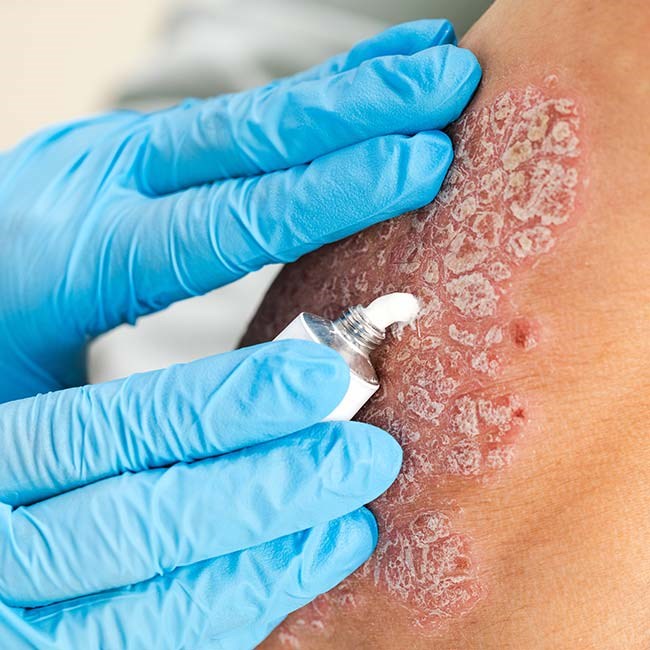Vitiligo is a skin condition that causes patches of your skin to lose their colour (pigmentation). It can run in families but it is not contagious, so you cannot catch it from someone else.
Here, we will explore the different types of vitiligo, its symptoms, progression, risk factors and treatment.
Who is at risk of vitiligo?
Vitiligo affects up to two in every 100 people worldwide. It occurs in people of all ages and skin colours. However, it usually develops before age 40 and is more obvious in individuals with darker skin tones.
If you have a first-degree relative (ie a parent, child or sibling) with vitiligo, you are more likely to develop the condition.
You are also more likely to develop vitiligo if you have an autoimmune condition or a family history of autoimmune conditions, that is, conditions where the body’s immune system mistakenly attacks its own cells.
Autoimmune conditions associated with an increased risk of vitiligo include pernicious anaemia, rheumatoid arthritis, Addison’s disease, psoriasis, type 1 diabetes and systemic lupus erythematosus.
Symptoms of vitiligo
Vitiligo causes patches of your skin to lose pigmentation, becoming a milky white colour. If those areas of your skin contain hair, it can also lose pigmentation, turning white, grey or silver.
Vitiligo can cause mucus membranes to lose pigmentation too. Mucus membranes are the moist linings of cavities in your body, such as in your mouth or nose.
While vitiligo can affect any part of your body, it most commonly affects the skin around the mouth and eyes, armpits, wrists, fingers, groin, genitals and feet, as well as the mucus membranes in the mouth.
The white patches caused by vitiligo begin as patches of paler skin that gradually become whiter and whiter, spreading outwards from the centre. In some individuals, a patch of skin may feel itchy just before it starts to lose pigmentation and/or as it starts to grow in size.
The edges of a patch can be smooth or jagged and can appear red and inflamed or brownish due to the accumulation of excessive amounts of pigment (hyperpigmentation).
Vitiligo can cause patches of almost any size, with more severe cases affecting large areas of the body. Affected patches of skin are not painful or more dry than unaffected skin.
Complications of vitiligo
Vitiligo doubles your risk of developing a type of hearing loss called sensorineural hearing loss. This is thought to occur because the immune system mistakenly destroys melanocytes in a vital structure for hearing called the cochlea, which sits inside your inner ear.
Vitiligo is also linked to an increased risk of certain eye problems, specifically inflammation of parts of the eye that contain melanocytes, namely iritis (inflammation of the iris) and uveitis (inflammation of a layer of the eye called the uvea).
Vitiligo can also lead to mental health issues due to the physical changes that can affect your self-esteem and may lead to social anxiety.
Types of vitiligo
There are broadly two types of vitiligo: segmental vitiligo and non-segmental vitiligo.
Non-segmental vitiligo, also known as generalised vitiligo or bilateral vitiligo, is the most common type of vitiligo. It affects nine in every 10 people with vitiligo and causes white patches to appear on both sides of the body, often in a symmetrical manner.
Segmental vitiligo, also known as localised or unilateral vitiligo, causes white patches to appear only on one side of the body and often only in one area. It is more common in children than adults, affecting one in three children with vitiligo.
In very rare cases, vitiligo can affect over 80% of the skin. This is called universal vitiligo.
How does vitiligo progress?
Vitiligo is a progressive skin condition, which means new areas of skin will become affected over time. However, the rate at which vitiligo spreads varies from one person to the next.
If you have vitiligo, you will experience phases where the condition is stable and no new patches develop, and phases where it is active where new patches develop and/or existing patches grow in size.
In general, non-segmental vitiligo progresses slowly, with new patches of affected skin developing every few years over a lifetime.
In contrast, segmental vitiligo usually starts with a period of rapid spread during the first six to 12 months of the skin condition. However, after this point, segmental vitiligo usually enters a period of stability and it is possible to not ever develop any new patches of affected skin.
What causes vitiligo?
Both non-segmental and segmental vitiligo are caused by a loss of melanin. Melanin is a pigment that gives your skin colour and is made by cells called melanocytes.
Melanocytes can make two types of melanin: eumelanin and pheomelanin. People of all skin colours have melanin but in different amounts and with a different balance of eumelanin and pheomelanin. When melanocytes are destroyed, levels of both types of melanin drop and vitiligo develops.
In non-segmental vitiligo, melanocytes are mistakenly destroyed by the body’s immune system. It is, therefore, an autoimmune condition.
In segmental vitiligo, melanocytes are destroyed by chemicals released by nerve endings in your skin that melanocytes are vulnerable to.
What triggers the destruction of melanocytes in non-segmental and segmental vitiligo is not entirely clear. However, several triggers are thought to be involved. This includes:
- Frequent skin exposure to phenol-containing chemicals (eg detergents)
- Hormonal changes such as during puberty, pregnancy and menopause
- Kidney or liver problems
- Severe sunburn or skin trauma — this triggers a skin response called the Koebner response
- Stressful events such as childbirth, bereavement and financial problems
As it is unknown why these triggers cause vitiligo in some people but not others, it is not possible to prevent vitiligo.
Getting a diagnosis of vitiligo
If you are concerned that you have vitiligo, see your GP. They will make a diagnosis based on an examination of your skin and your answers to questions about your medical history and lifestyle, and family medical history.
For example, they may ask if you have recently experienced any trauma to your skin in the affected area, whether your symptoms have improved or worsened, and whether you think something in particular has triggered your symptoms.
They may also ask about symptoms unrelated to your skin that may indicate that you have an undiagnosed autoimmune condition (eg type 1 diabetes or Addison’s disease) that is associated with a higher risk of vitiligo.
As other skin conditions can cause loss of skin pigment, your GP may need to more closely examine your skin under a Wood’s lamp.
A Wood’s lamp is a type of UV lamp. Shining UV light on the affected patches of skin will help your doctor determine whether or not your skin changes are due to vitiligo or another skin condition.
Treating vitiligo
Vitiligo cannot be cured; however, treatments are available to temporarily restore some pigment to white patches. As these effects are temporary, there is currently no treatment available to stop the spread of vitiligo over time.
Skin camouflage
For small white patches, skin camouflage can be used to cover them up and match them to the surrounding unaffected skin. Skin camouflage includes a variety of techniques, including makeup, fake tan and medical tattooing.
Pigment restoration
To temporarily restore pigment to white patches, corticosteroid creams are sometimes effective. However, they are not recommended for long-term use as they can thin the skin and cause stretch marks.
Light-based therapy, namely phototherapy using narrow-band ultraviolet B, can also help restore pigment in some cases. This usually takes at least three months of phototherapy two to three times a week before changes become noticeable.
Surgery
If you have tried other treatments without success and have stable vitiligo, your doctor may recommend skin grafting surgery.
This involves removing healthy, unaffected skin from one part of your body and transplanting it to cover up a white patch.
This procedure is only suitable if you have not had any new patches develop in the last 12 months and if your existing patches have not become worse in the last 12 months.
For small patches of vitiligo, a type of skin grafting called blister grafting may be used. This involves forming small blisters on your healthy, unaffected skin, usually using suction, and transplanting these blisters to cover small white patches.
Skin grafting is not suitable if your vitiligo was triggered by skin trauma, such as severe sunburn.
An alternative to skin grafting is cellular suspension therapy. This involves collecting a small sample of healthy, unaffected skin cells, suspending them in fluid, and transplanting this fluid to white patches of skin.
Depigmentation
If over half of your skin is affected by vitiligo, you may want to create areas of uniformity through depigmentation. This removes pigment from healthy skin so that this area becomes completely white.
It involves applying a depigmenting lotion containing hydroquinone onto healthy skin. The effect is usually permanent.
Sun protection
If your vitiligo patches are not interfering with your quality of life and you, therefore, do not want treatment, it is nonetheless important that you practice good sun safety.
When your skin is exposed to sunlight, it darkens as a protective measure by producing melanin. The white patches caused by vitiligo cannot do this and, therefore, are at higher risk of becoming sunburnt.
Consequently, if you have vitiligo, it is important to regularly apply sunblock that provides a sun protection factor (SPF) of 50 or higher.
Conditions mistaken for vitiligo
There are several other skin conditions that cause patches of skin to lose pigment.
This includes the fungal infection pityriasis versicolor and chemical leukoderma, which is caused by exposure of the skin to certain industrial chemicals.
In children, white patches can form temporarily due to pityriasis alba. This is not caused by any type of infection and is not contagious. It usually goes away on its own during childhood.
In albinism, the skin produces very little melanin; however, this occurs across the entirety of the body and, therefore, is different to vitiligo, which occurs in patches.
Where to find help and support
If you have vitiligo, you can find support by visiting your GP. You can also learn more about the condition and find support and advice from several UK charities. This includes The Vitiligo Society, Vitiligo Support UK and Changing Faces.


